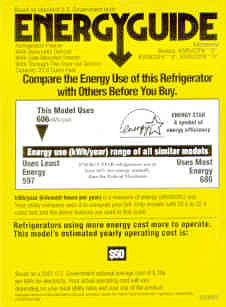|
Thread Number: 12436
Introducing me & few questions |
[Down to Last] |

|
Post# 217921 , Reply# 2 6/24/2007 at 06:08 (6,144 days old) by panthera  (Rocky Mountains) (Rocky Mountains) |
||
Hi and Welcome!
Gabriele, I can answer your questions, but some other people here might have better answers, here goes. 1) US appliances have a simple "ENERGYGUIDE" yellow sticker which compares the "operating cost" per annum of this appliance with the similar appliances. It is primitive, inaccurate and is very often criticized. Basically, American consumers have to ask and look up the information for themselves. The current US government is not interested in consumer protection, only in manufacturer protection. There is an additional label called "energy star" which is given to appliances which are better than the average. There is a picture, below. 2) Here is what "Lowe's", a big American retailer says: (see link for more) Washers Whether you wash a few loads a week or a few loads a day, energy-efficient washers can contribute tremendous savings. Full-sized ENERGY STAR® qualified washers use 16-25 gallons of water per load, compared to the 40 gallons used by a standard machine. For example, top loading washing machines can save as much as 10,000 gallons of water per year and about $100 in utility bills. Front-loading washing machines can save even more — up to 12,584 gallons of water per year. (end of quote) But all the Americans are complaining that the clothes don't get clean and they aren't well rinsed at the lower levels. You can think of one gallon as about 4 liters.(*) Information about the power consumption is listed on the yellow lable, but noise levels are only on the manufacturer's website, if they care to list them. By nature, TLs are very much louder than FLs. The motors are usually very sturdy split-phase induction, not three-phase or brush driven (this is changing) and draw about 6-8amps at 115V. 2a. Vintage machines vary too much to say, I think Unimatics used just over 40 gallons and cleaned and washed very well; some Kelvenators used twice as much. This is because of something called "over-flow" rinsing which was an attempt to flush the dirty soap-scum up and out of the clothes instead of spining the water out through the clothes or draining it down through the clothes, both of which could leave the soap and dirt trapped as a layer on the clothes. 3. American dryers are wonderful. Much better than what we have in Europe. They draw around 4800 to 6000 Watts. They are run at 240V, split-phase AC.** It takes them about one hour to softly dry seven kilos of cottons. Vintage dryers used about the same, but some had different wattage elements and could adjust the wattage to match the heat needed. This was a better method than today's system of only using a thermostat to cycle one high-temperature element on and off. Dryers are the only machine where Americans are very far ahead of us in Europe. Cercare il pelo nell'uovo: * One US gallon is exactly: 3.785 liters ** Most Americans call split-phase "two-phase". True three-phase like we have it in Europe is only used in the US for very big agricultural machinery and manufacturing. I hope this helped, there will be more replies when the Americans start waking up. CLICK HERE TO GO TO panthera's LINK 
| ||
| Post# 217936 , Reply# 4 6/24/2007 at 08:58 (6,144 days old) by mielabor () | ||
|
Most Americans call split-phase Do I understand correctly that American 220 Volt is obtained with two 127 Volt phases? That is interesting, we had the same system in Amsterdam until circa 15 years ago. I know that it was, and maybe still is, used in Brussels. | ||
Post# 217942 , Reply# 5 6/24/2007 at 09:29 (6,144 days old) by dadoes  (TX, U.S. of A.) (TX, U.S. of A.) |
||
|
| ||
Post# 218825 , Reply# 15 6/27/2007 at 14:56 (6,141 days old) by gadgetgary  (Bristol,CT) (Bristol,CT) |
||
 | ||

 Comes to the Rescue!
Comes to the Rescue!